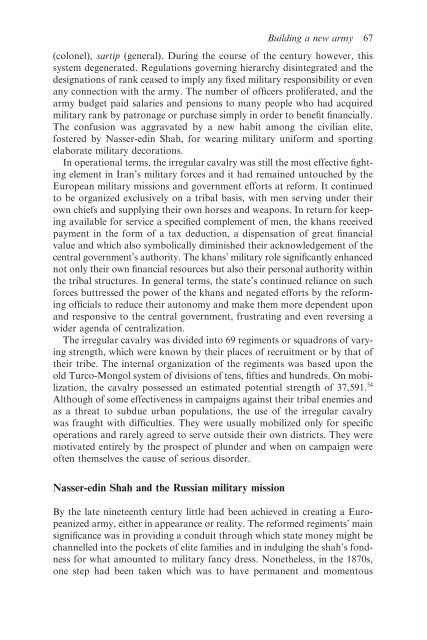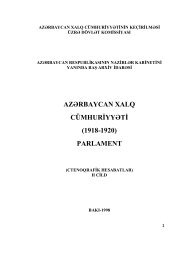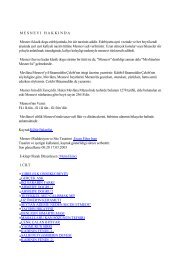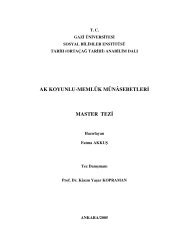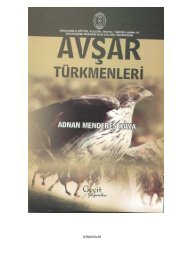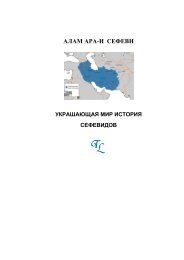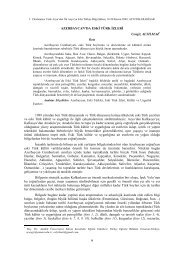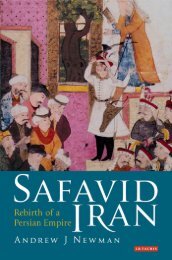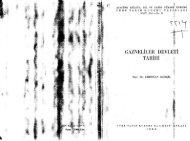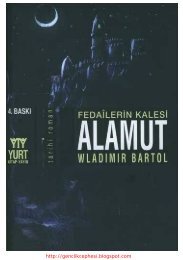War and Peace in Qajar Persia: Implications Past and ... - Oguzlar.az
War and Peace in Qajar Persia: Implications Past and ... - Oguzlar.az
War and Peace in Qajar Persia: Implications Past and ... - Oguzlar.az
- No tags were found...
You also want an ePaper? Increase the reach of your titles
YUMPU automatically turns print PDFs into web optimized ePapers that Google loves.
Build<strong>in</strong>g a new army 67(colonel), sartip (general). Dur<strong>in</strong>g the course of the century however, thissystem degenerated. Regulations govern<strong>in</strong>g hierarchy dis<strong>in</strong>tegrated <strong>and</strong> thedesignations of rank ceased to imply any fixed military responsibility or evenany connection with the army. The number of officers proliferated, <strong>and</strong> thearmy budget paid salaries <strong>and</strong> pensions to many people who had acquiredmilitary rank by patronage or purchase simply <strong>in</strong> order to benefit f<strong>in</strong>ancially.The confusion was aggravated by a new habit among the civilian elite,fostered by Nasser-ed<strong>in</strong> Shah, for wear<strong>in</strong>g military uniform <strong>and</strong> sport<strong>in</strong>gelaborate military decorations.In operational terms, the irregular cavalry was still the most effective fight<strong>in</strong>gelement <strong>in</strong> Iran’s military forces <strong>and</strong> it had rema<strong>in</strong>ed untouched by theEuropean military missions <strong>and</strong> government efforts at reform. It cont<strong>in</strong>uedto be organized exclusively on a tribal basis, with men serv<strong>in</strong>g under theirown chiefs <strong>and</strong> supply<strong>in</strong>g their own horses <strong>and</strong> weapons. In return for keep<strong>in</strong>gavailable for service a specified complement of men, the khans receivedpayment <strong>in</strong> the form of a tax deduction, a dispensation of great f<strong>in</strong>ancialvalue <strong>and</strong> which also symbolically dim<strong>in</strong>ished their acknowledgement of thecentral government’s authority. The khans’ military role significantly enhancednot only their own f<strong>in</strong>ancial resources but also their personal authority with<strong>in</strong>the tribal structures. In general terms, the state’s cont<strong>in</strong>ued reliance on suchforces buttressed the power of the khans <strong>and</strong> negated efforts by the reform<strong>in</strong>gofficials to reduce their autonomy <strong>and</strong> make them more dependent upon<strong>and</strong> responsive to the central government, frustrat<strong>in</strong>g <strong>and</strong> even revers<strong>in</strong>g awider agenda of centralization.The irregular cavalry was divided <strong>in</strong>to 69 regiments or squadrons of vary<strong>in</strong>gstrength, which were known by their places of recruitment or by that oftheir tribe. The <strong>in</strong>ternal organization of the regiments was based upon theold Turco-Mongol system of divisions of tens, fifties <strong>and</strong> hundreds. On mobilization,the cavalry possessed an estimated potential strength of 37,591. 54Although of some effectiveness <strong>in</strong> campaigns aga<strong>in</strong>st their tribal enemies <strong>and</strong>as a threat to subdue urban populations, the use of the irregular cavalrywas fraught with difficulties. They were usually mobilized only for specificoperations <strong>and</strong> rarely agreed to serve outside their own districts. They weremotivated entirely by the prospect of plunder <strong>and</strong> when on campaign wereoften themselves the cause of serious disorder.Nasser-ed<strong>in</strong> Shah <strong>and</strong> the Russian military missionBy the late n<strong>in</strong>eteenth century little had been achieved <strong>in</strong> creat<strong>in</strong>g a Europeanizedarmy, either <strong>in</strong> appearance or reality. The reformed regiments’ ma<strong>in</strong>significance was <strong>in</strong> provid<strong>in</strong>g a conduit through which state money might bechannelled <strong>in</strong>to the pockets of elite families <strong>and</strong> <strong>in</strong> <strong>in</strong>dulg<strong>in</strong>g the shah’s fondnessfor what amounted to military fancy dress. Nonetheless, <strong>in</strong> the 1870s,one step had been taken which was to have permanent <strong>and</strong> momentous


